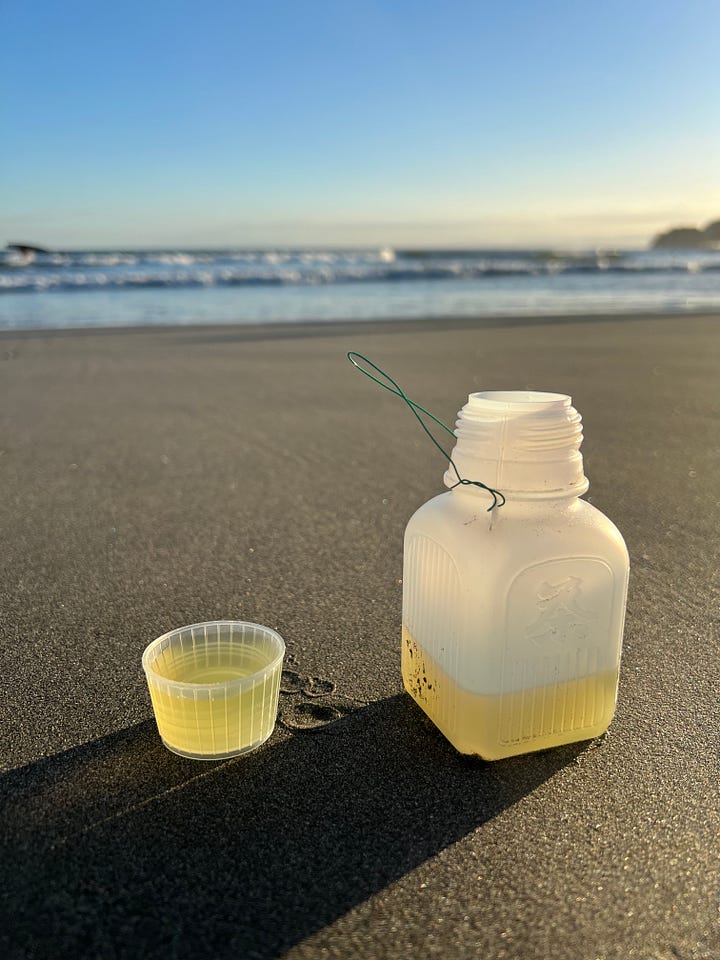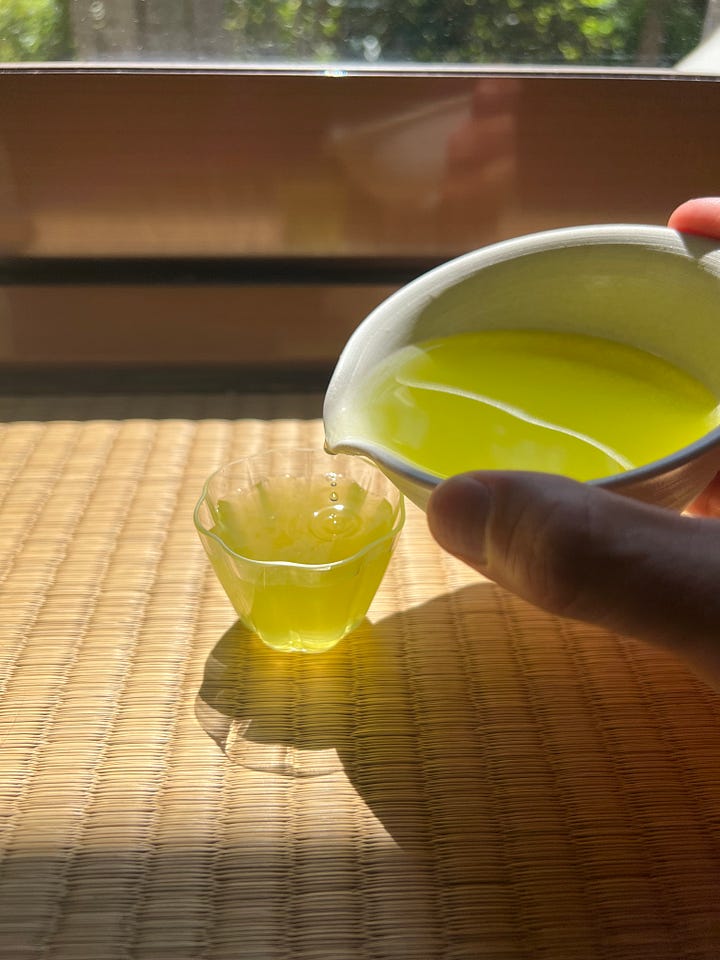Pairing 003: Gil Scott-Heron’s “A New Vibration” x Cold Brew Green Tea on the Beach
In which I compare the grains of sand between my toes to those in the hourglass.
“I never go any place twice that I don’t like,” – Gil Scott-Heron, Live in Eugene 1978
What’s your favorite place in the world? Does it contain certain ingredients—memories, people, natural features, restaurants—that you cannot find elsewhere? Has it always been your favorite, or have you only grown into it? How much does familiarity or newness matter? In what ways does it support or challenge you? Is it full of surprises, reliability—both?
I may not be ready to call Kamakura my favorite place in the world forever—but I am ready to call it my favorite place in the world right now. I’m tempted to articulate my affection for it here, to run through the checklist, to paint the picture. But it remains foremost a feeling—and one I’m not sure I’ve felt before—that’s rooted in safety, in trust.
To answer my own questions: I think Kamakura does contain ingredients–memories I’m making daily (slices of pavement where a conversation took place or a plant upon which my bicycle was thrown by a perturbed neighbor), people I’m growing to know (a chicken-making gallery owner who is as unsure of the bicycle parking rules as I am), natural features I’m exploring (the shape of the waves changing in typhoon season), restaurants I’m tasting (a curry place that serves up three kinds of a curry in an artful color wheel)—all of which are unable to be found elsewhere. From the first moment I set foot in this town 8 years ago, I think I’d felt a strong connection to it, but I have also grown into accepting that connection as bigger and more cosmic than I original sensed. It’s a combination of familiarities—flashes of Southern California—and novelties—seemingly never-ending alleys, each with its own treasures to unearth (it’s lengthy history, offering a bottomless ocean of Shakespearean tragedy to explore)—that matter in how well they are paired.
Perhaps, most of all, it challenges me by supporting my life unfolding at its own pace—which has become a continual and reliable surprise.
Right now, a love letter to this place is being across the contours of my heart and I will share it when it’s ready to be electrocardiogram to the page. Until then, let’s listen to some music and drink some tea together.


I’ll leave the tea up to you: cold brew shizuoka gyokoru from Hoshino-en in Yame on the sand with the ocean breeze in a old-school Japanese-train inspired container with a plastic top that becomes a top (from Chaseki in Hakone), or cold brew kirari 31 single orgin shincha from Osada En in Shizuoka on your tatami mat with the AC on (with your Kobayashi glass cups and white yuzamsashi from Maekawa San). Just make it cold and green.
Last month a gentleman I consider a friend—Rumal Rackley—reached out to let me know he was coming to Los Angeles and to share the news that his father, Gil Scott-Heron, was releasing a new posthumous live album: A New Vibration (Live Eugene 1978).
***Editors note: Rumal has informed me that, in fact, the album I wrote about here “A New Vibration” is in fact a sort of rogue live album—that may or may not be completely off Spotify in the near future—and the one he originally reached out to me about is Gil Scott-Heron & His Amnesia Expression “Legend In His Own Mind) Live, Bremen 1983). I will write more about that album later this week, but consider what follows to be a sort of accidental adventure with, perhaps, not-so-accidental insights.
I won’t belabor how much Gil Scott-Heron’s music has meant to me on an artistic and existential level. I will instead point to what I wrote about him and his memoir—The Last Holiday—8 years ago. Somewhere between the reality that my life used to revolve around new music releases and concerts—and the fact that I haven’t been to a live show since Kamasi Washington in December 2022 (8 months ago), I still found myself thrilled when Rumal told me that this record was coming out.
Every new Gil Scott-Heron project that’s been released since I’ve cared deeply about his work—whether I’m New Here (2010), We’re New Here (2011), Nothing New (2014), or We’re New Again (2020)—has struck a chord with me and with the music loving world at large. Continuing with this ‘new’ theme, A New Vibration (released 2023) does offer novel glimpses into what his shows were like. I loved the more urgent renditions of familiar songs like “Hello Sunday, Hello Road” and “We Almost Lost Detroit.” I got down on the meandering solos from the Midnight Band. But it’s the phrasing of GSH’s scats, raps, and asides that plucked my heart strings most.
During the set he keenly elaborates on a song title—like on “Song of the Wind”—and leads the band through a marathon masterclass of “The Bottle” — and delves deeply elsewhere as he does during the album opening and during the lengthy introduction to “Home Is Where The Hatred Is” where he demythologizes midnight itself:
Midnight is a corner you might try to hide in every once in a while
Look at it as a safe and sensible sanctuary
Darkness prevails there’s no need for anything other than darkness here
It is an area that exists in between and people who seek to run away often run there
Existing as it does between yesterday and tomorrow
It affords people an opportunity to run away from things that are chasing them from yesterday
And hide from things that they can’t face that represent tomorrow
A combination of things physical and mental and spiritual
Elements that collide like covers and become washed away into the darkness of Midnight
How I wish there were unpublished Gil Scott-Heron manuscripts somewhere. How I hope more recordings of his shows remain to-be-released. How I yearn to visit more of the places that spoke to him. But, most of all, how I wish I could hear him demythologize noon. How I wonder what he’d have to say about daylight.
Because I’m growing less familiar with midnight now. I find myself, against the odds, living in the sunshine of noon and don’t always know what to do with so much light. I see no junkies walking through the twilight on my way home. I watch my dog pause in the early mornings and evenings and look up to the hill as a breeze blows.
Shops close early in Kamakura. People rise with the sun and run on the beach. I run with them and drink my cold brew teas on the sand at sunset and play in the sand and float on the waves like a child. Yesterday and tomorrow matter less than they did before, less to run toward or away from.
Home is no longer only where the needle marks try to heal broken hearts. I’ve left that home behind and although it will always be a part of me, I have also found something else. I’m widening. That Gil Scott-Heron, that my own father, or my mother, cannot bask in this abundance of light with me is starting to break my heart less than it used to.
This is what a place that you like can do to you—and maybe those places are worth going back to ten thousand times.
If the sand between my toes is the same as the sand left in the hourglass—and the sand that made that hourglass—then it delights me that at least some of that sand lines the beaches along Kamakura’s shores.
And I hope you can find your Kamakura and your tea and if you can’t, and you suffer for it, then maybe you just have to keep going a little longer—or you have sit still and listen to the spaces between the words of your favorite artist—and hear all the things that aren’t being said.
I once thought I’d outsmarted all my demons and I ran away to Brazil. Now I look at the clock and realize that in 28 minutes it will be midnight in Rio De Janeiro and it will be noon here in Kamakura.






